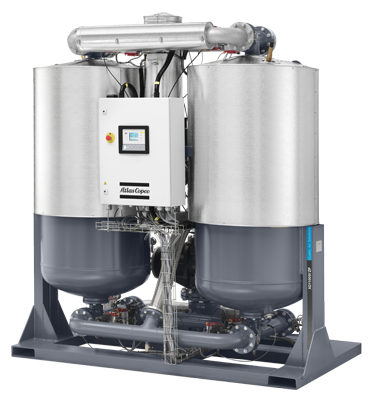Desiccant Dryer

When
a compressed air application requires a pressure dew point
under 0°C, a desiccant dryer is required to meet the
specification. Desiccant dryers usually contain two pressure
vessels, both filled with desiccant (activated alumina
beads).
Adsorption Dryer
The moisture from the compressed air clings, like Velcro
to the desiccant when the air passes through the first tower.
After a period of time, when the beads in that tower are
saturated, the compressed air is switched to pass through the
second vessel while the first vessel is then flooded with air
to dry out the saturated beads. This process is then repeated
after a set period when the beads in the second tower are
saturated, moving the flowing air back to the first vessel
while the second vessel is regenerated and so on. To
regenerate desiccant beads, there are two techniques that are
commonly used.
Cold Regeneration
A small amount of the compressed air that has dried,
expands to atmospheric pressure in cold regeneration dryers
and the saturated desiccant vessel is sent over. The air is
much dryer due to the compressed air expansion. The moisture
moves from the desiccant to the dried air and into the
atmosphere. This type of regeneration results in very short
cycle times and a small amount of electricity – only
for the controls. The design is simple and reliable, but up
to 18% of the compressor power is used for regeneration,
making it a costly solution especially for low pressures.
Heat Regeneration
In this method, moisture is released from the desiccant
beads when they are heated and water retaining forces break.
Air flow moves the moisture out of the saturated vessel.
These are the types of heat regenerated adsorption
dryers:
Heated Purge
In heated purge desiccant dryers, part of the dried
compressed air expands to atmospheric pressure and heat is
sent to raise the temperature to 150-180°C. Saturated
desiccant sends hot air through the vessel, moisture is
released and moves to the atmosphere with the air. In heated
blower purge desiccant dryers, a blower is installed that
moves ambient air to a heater. The air is warmed up to
150-180°C, and travels through the vessel with the
saturated desiccant. Moisture is released and travels to the
atmosphere with the air.
Heat of Compression
Heat created during compression is used in heat of
compression desiccant dryers to warm the desiccant and remove
moisture. Hot compressed air moves from the compressor
through the saturated vessel, moisture is released, and
travels with the compressed air to a cooler. The compressed
air is then cooled, and moisture is removed. The compressed
air moves from the cooler to the vessel containing dry
desiccant. Here, the remaining moisture is eliminated and dry
air enters the compressor system. Before the desiccant beads
can begin adsorbing again, they must cool down with cold
ambient air, or with dry or cold compressed air.
HTE Compressed Air Solutions is your resource for all your
outdoor, or high purity compressed air dryer equipment and
service needs if you are in Kansas,
Missouri or Illinois.

 When
a compressed air application requires a pressure dew point
under 0°C, a desiccant dryer is required to meet the
specification. Desiccant dryers usually contain two pressure
vessels, both filled with desiccant (activated alumina
beads).
When
a compressed air application requires a pressure dew point
under 0°C, a desiccant dryer is required to meet the
specification. Desiccant dryers usually contain two pressure
vessels, both filled with desiccant (activated alumina
beads).